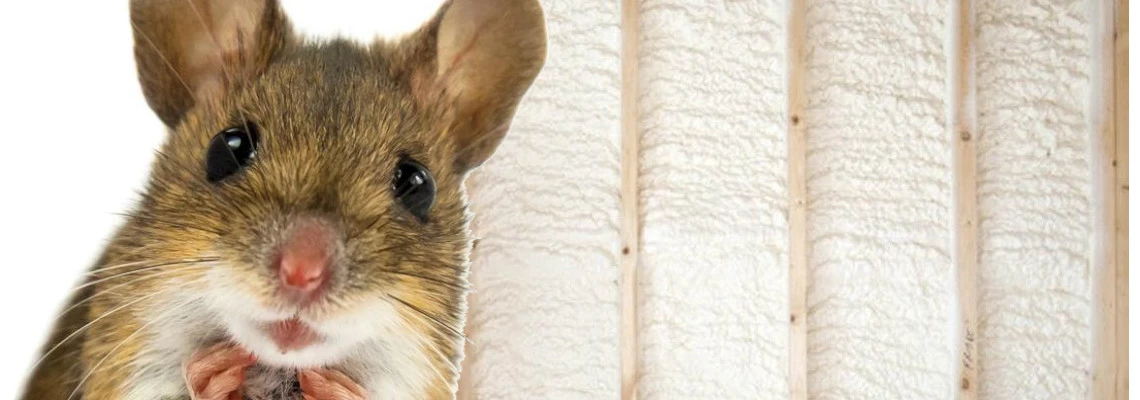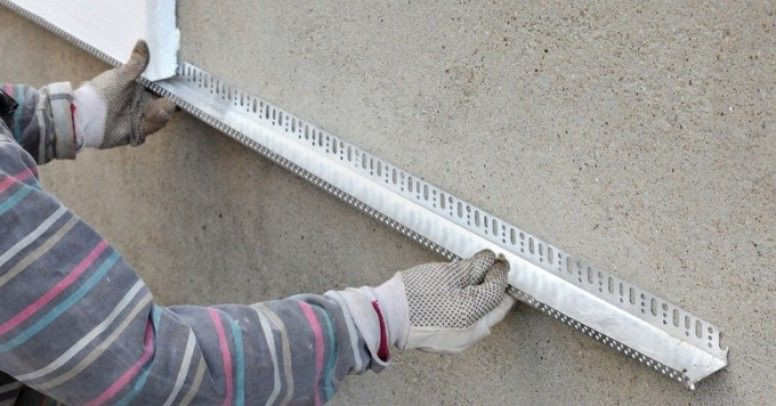
THE BEST INSULATIONS TO KEEP UNWANTED RODENTS AT BAY*
Mice are probably the most unwelcome guests in a home. They can cause damage, spread diseases, and even potentially lead to a house fire by chewing on wires. If you're seeking effective methods to keep mice from invading your living space, one vital factor to consider is your home's insulation. In this blog, we'll delve into insulations that deter mice and discuss their role in safeguarding your home.

A DAY IN THE LIFE OF A MOUSE
Mice are small rodents that have adapted remarkably well to urban environments such as London. Understanding their behaviour and what draws them into our homes can help us mitigate infestations effectively.
MICE'S NATURAL HABITS:
Mice are primarily nocturnal creatures, which means they are most active during the night when it's dark and quiet. This behaviour helps them navigate more easily. Mice are known for their impressive ability to nest almost anywhere. They seek shelter in concealed, warm, and dark spaces, making wall voids, attics, and insulation ideal nesting spots.
Mice are opportunistic eaters. They'll consume grains, seeds, fruits, and even small insects or meat when available.
Mice reproduce rapidly, with a single pair capable of producing several litters per year, each with multiple offspring. This high reproductive rate contributes to their ability to establish populations quickly.
WHY MICE ENTER HOMES:
One primary reason mice enter our homes is to find shelter from harsh weather conditions, especially during the colder months. The warmth and protection offered by buildings are attractive to them.
The availability of food is a major attractant for mice. Crumbs, spilled grains, pet food, and open food containers are all enticing to them. Mice have keen senses of smell and can detect food from a distance.
Mice also need water to survive, so homes with accessible water sources are more appealing. Leaky pipes, dripping faucets, or standing water can attract them.
Once inside, mice look for suitable places to build nests and raise their young. Wall cavities and undisturbed areas provide secure locations for breeding.
THE WAYS MICE ENTER YOUR HOME
Mice enter our homes primarily for shelter, food, water, and breeding sites. Mice can squeeze through incredibly small openings, as they have flexible bodies and can flatten themselves to fit through 8mm gaps. Any cracks, holes, or openings in a building's exterior can serve as entry points. Here are a few main places through which mice enter your home:
- Ventilation openings
- Unlocked doors, even for just a few minutes
- Chimney
- Attic
- Utility openings or ducts
- Windows
- Foundation Cracks
- Garage or Basement Doors
- Holes in Walls
- Gaps around pipes, utility lines, or electrical conduits
- Gaps Around Rooflines
THE BENEFITS OF PREVENTING MICE INFESTATIONS
Dealing with a pest infestation can be a stressful and costly. However, taking proactive measures to prevent infestations in the first place is not only more cost-effective but also provides numerous other benefits. Prevention should be your first line of defence against infestations and the advantages it offers:
Cost Savings: Prevention measures are typically much more affordable than the expenses associated with eradicating a full-blown infestation. This includes the cost of professional pest control services, repairs, and replacements for damaged property.
Reduced Health Risks: Infestations can pose health risks due to the spread of diseases, allergens, and contaminants. Preventing pests from entering your home helps protect your family's health.
Less Disruption: Dealing with an infestation can disrupt your daily life, from having to vacate your home during treatments to the stress of constant pest encounters. Prevention keeps these disruptions at bay.
Preservation of Property: Pests can cause extensive damage to your property, from gnawed wires and insulation to structural harm. Preventing their entry ensures the longevity and value of your home.
Peace of Mind: Living in a pest-free environment provides peace of mind, knowing that your home is a safe and healthy place for you and your family.
Environmental Responsibility: Many pest control methods involve the use of chemicals that can harm the environment. Prevention minimizes the need for such treatments, contributing to a more sustainable living.
Time Savings: Dealing with an infestation can be a time-consuming process. Preventing pests upfront saves you the hassle of spending time and energy on pest control.
Long-Term Effectiveness: Prevention is a long-term solution, whereas treating infestations may require ongoing efforts to keep pests at bay once they've infiltrated your home.
2 ✅ TYPES OF INSULATION MICE AVOID
Mice tend to establish their nests in warm, less frequented areas that are often inaccessible to humans. That's why insulation is typically their top choice for nest-building. However, there are certain types of insulation that significantly hinder, if not entirely prevent, mice from reproducing. You can use the following insulation materials to deter mice from creating nests:
FOIL-FACED INSULATION
Mice will chew on nearly anything, but they tend to avoid materials like aluminium due to its sharp edges, which can harm their teeth and cause pain. Consequently, insulation with an aluminium coating is often bypassed by mice. Areas filled with this type of insulation are less appealing to them, as biting into it is problematic. Small pieces of aluminium can get stuck in their teeth, causing discomfort. Furthermore, it appears that mice tend to steer clear of rock wool insulation. The environment it provides can lead to blindness in mice, and the reproduction process in this insulation occurs significantly slower. Many mice born in mineral wool are blind, and their skin is often irritated.
SPRAY FOAM INSULATION
Spray foam insulation is another type of insulation that makes it difficult for mice to establish nests. Unlike other insulation materials, spray foam lacks oxygen in its structure, creating unfavourable conditions for mouse reproduction. As it is typically closed-cell insulation, its structure is compact and tight, making it challenging for mice to penetrate. Within such insulation, mice cannot move around or create pathways, further deterring their presence.
These insulation types create barriers that mice find challenging to navigate, making them less attractive for nesting.
INSULATION THAT MICE PREFER
It's crucial to keep in mind that there are insulation materials available that mice find quite attractive. These insulations provide a harmless environment for them, and chewing through them poses minimal difficulties. One such material is low-density polystyrene (EPS), which is susceptible to mice nesting. Its open-cell structure makes it soft and easy to damage, which mice find appealing. Styrofoam is very warm and easy for them to gnaw on. It has also been observed that mice can even eat small amounts of Styrofoam. Therefore, Styrofoam can serve as a type of food for them when no other food sources are available around.
Polystyrene (Styrofoam) is often used as an insulation material for the exterior walls of homes. Failure to protect it with aluminium starter trim can provide nothing but an easier pathway for pests to penetrate. External Wall Insulation (EWI), specifically its final layer, known as thin coat render, is virtually impenetrable to these rodents. It consists of silicone-based adhesive substances. The only potential entry point for mice would be the lower part of the insulation. Therefore, it's essential to always use aluminium trim, which completely blocks access for rodents.
Picture credit: nicoleyounie.co.uk
SUCCESS STORIES OF PEOPLE WHO SUCCESSFULLY ERADICATED RODENTS FROM THEIR HOMES
There are remarkable success stories of individuals who have effectively battled these pests in their homes. One of the most effective methods for combatting mice infestations is homes insulated with spray foam. Homes insulated with spray foam are renowned for their exceptional airtightness and insulation properties. This unique feature not only provides energy efficiency but also serves as a formidable defence against rodent intrusions. Remarkably, statistics show that a staggering 90% of homes insulated with spray foam never experience mouse interference again after installation.
CONCLUSION
In conclusion, the significance of mouse-proofing your home with effective insulation cannot be overstated. Mice, while seemingly small and inconspicuous, can bring about a range of problems and inconveniences, from property damage to health risks.
Homes insulated with materials like spray foam, which offer exceptional airtightness and mouse deterrence, stand out as success stories in the battle against rodent infestations. The statistics speak for themselves, with an impressive 90% of such homes remaining free from mouse intrusions.
The key lies not only in the choice of insulation but also in the meticulous sealing of all potential entry points, ensuring that your home is airtight and impenetrable to mice. By doing so, you safeguard your property, your family's health, and your peace of mind.
Remember, mouse-proofing is not merely a matter of convenience; it's a crucial investment in the long-term well-being and safety of your home. As these stories have shown, with the right insulation and prevention measures, you can create a haven that remains free from these troublesome pests, allowing you to enjoy a healthier and more comfortable living environment for years to come.
Related articles:
ENHANCING FIRE SAFETY WITH MINERAL WOOL INSULATION
WHAT TO CONSIDER WHEN CHOOSING INSULATION MATERIALS
MASTERING HOME INSULATION: UNLOCKING COMFORT, ENERGY EFFICIENCY, AND SAVINGS
TOP INTERIOR WALL INSULATION PRODUCTS: A COMPREHENSIVE GUIDE
*All the information provided in the content published on Insulationgo blog is for informational and educational purposes only. Insulationgo LTD makes every effort to ensure the accuracy and timeliness of the content, but we do not assume any responsibility for any errors or omissions.
The information presented on this blog should not be considered as professional advice or a substitute for consulting relevant experts. Before making any purchase decisions or taking action based on the information presented here, it is strongly recommended to contact the product manufacturer directly to verify the details and ensure its suitability for your specific needs.
Any descriptions, drawings, photographs, data, proportions, weights, measured values etc. given herein may change without prior notice and do not constitute the agreed contractual quality of the products. It is the responsibility of the recipient of all products to ensure that any proprietary rights and existing laws and legislation are observed.
By using this blog, you acknowledge and agree that Insulationgo LTD shall not be held liable for any damages, losses, or inconveniences arising from the use or reliance on the information provided herein. This limitation of liability applies to all users of the blog, including but not limited to visitors, readers, and subscribers.











































































































